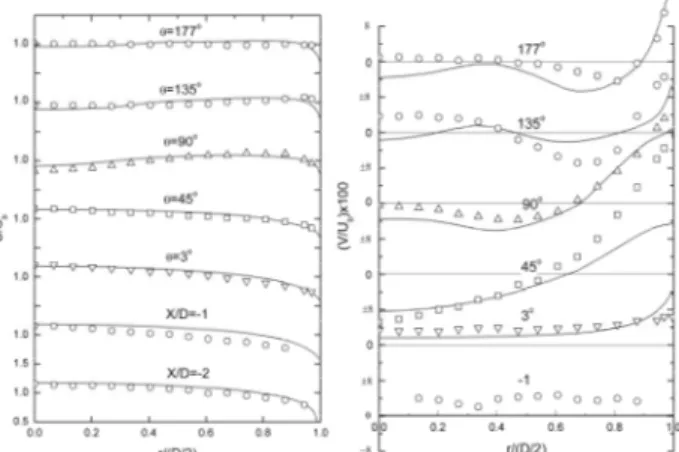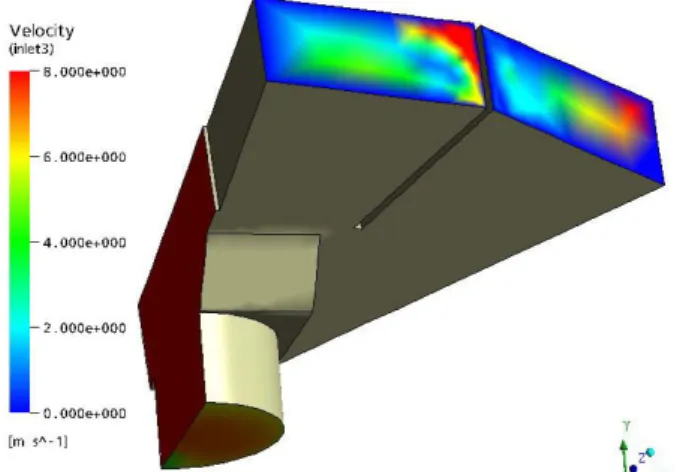Predicting Velocity Profiles on the Inlet Nozzles
for the Simulation of the Wolsong 2/3/4 Moderator Circulation
Churl Yoon, Joo Hwan Park
Korea Atomic Energy Research Institute, 150 Dukjin-Dong, Yusung-Gu, Daejon, Korea E-mail cyoon@kaeri.re.kr
1. Introduction
In the moderator analysis of the CANDU-6 NPPs, a 3-dimensional CFD is used to estimate the local moderator subcooling in the Calandria vessel. The moderator circulation pattern is determined by the combined forces of the inlet jet momentum and the buoyant flow. Even though the inlet boundary condition plays an important role in determining the moderator circulations, any experimental data of a detailed inlet velocity profile has not been available. Thus, the purposes of this study are to evaluate the abilities of CFX-5.7[1] for predicting the moderator nozzle flow, and to get the velocity profiles through the real moderator inlet nozzle.
The inlet nozzle geometry consists of a circular pipe, a 90o circular bend, and a nozzle. The whole domain is divided into three separated flow regions, which are characterized as a straight pipe flow, a curved pipe flow, and an impinging jet. In the second section, the simulation results are compared with experimental data for three kinds of conventional fluid flows. In the next section, the inlet nozzle flow through the real nozzle assembly has been predicted using the obtained technology of the CFD simulation.
2. Prediction Capability of CFX-5.7
Three conventional experimental data for a circular pipe flow, a curved pipe flow, and an impinging jet are chosen for the test of CFX-5.7. Several turbulent models and grid spacing are tested for each case. The obtained knowledge about the turbulent model, the meshing, and converging technique are adapted for the prediction of the inlet velocity profiles through the real moderator nozzle.
2.1 Circular Pipe Flow
As a test case of a pipe flow, some experimental data of Laufer[2] are compared with simulation results in Fig. 1. Five different turbulence models are tested. In the low-Reynolds near-wall treatment(k-ω, Baseline k-
ω
, and SST models) a switching from wall functions to a low-Re near wall formulation happens automatically. The number of cells is 6,900 in the r-θ plane and the near-wall y+ value is 0.6. In the scalable wall function(k-ε and SSG models), the number of cells is 2,400 in the r-θ plane and the near-wall y+ value is ~11. Grid independency was confirmed. The flow is fully developed and the Re number is 40,000.The entire turbulent models show good agreement with the experimental data except for the abrupt change of the turbulent intensity near the wall.
Figure 1: k profile of circular pipe flow at Re = 40,000
2.2 Curved Pipe Flow
A test simulation was performed to check whether CFX-5.7 can predict the secondary flows of a curved pipe flow correctly. A experimental study of non-swirling flows in a curved pipe by Azzola[3] was selected for the validation. The Re number is 57,400. Working fluid is water. Figure 2 shows the comparison of the longitudinal (U) and circumferential (V) mean velocity components at sequential longitudinal stations. The negative sign of X/D means the upstream side of the straight tangents, which are connected to the 180o curved pipe. One of the Reynolds stress turbulence models, SSG model, is used associated with scalable wall functions. This SSG model was developed by Speziale, Sarkar and Gatski[4].
Figure 2: Velocity components of a curved pipe flow Transactions of the Korean Nuclear Society Autumn Meeting
2.3 Impinging Jet
A normally-impinging jet from a circular nozzle is simulated and the results are compared with the experimental data by Cooper[5]. A turbulent air jet impinges orthogonally onto a large plane surface. The Re number at the nozzle is 70,000. The nozzle diameter D is 101.6 mm and the height of the jet discharge is 2D. The nozzle pipe is long enough, so that the flow at the pipe exit is fully-developed. The Shear Stress Transport (SST) turbulent model gives the best matching results with the experimental data as shown in Fig. 3. The y+ values at the opposite wall are less than 1. Ub is the bulk velocity, R is the radial distance from the center in meters, and y is the height from the wall. Comparison between the simulation results and the experimental data shows a good agreement for the overall trends.
Figure 3: Streamwise velocity components of an impinging jet
3. Computational Prediction of Inlet Nozzle Flow
Each nozzle is connected to a 6” elbow and a 6” pipe. Moderator passes though a 2m-long pipe, goes into a 90o bend and then flows into inlet nozzles. Because the memory capacity is limited and different turbulent models are suitable for each flow region, the simulation on each section is performed separately. The locations of the interfaces between the regions are selected carefully so as not to disturb the prediction. The velocity components and turbulent parameters at the interface are transferred to the inlet boundary conditions of the next flow region. For simplicity, the flow is assumed to be fully developed at the entrance of the curved pipe. The domain is steady-state, stationary, and under the reference pressure of 1.5 atm. The working fluid is heavy water at 45oC, which has a density of 1084.7 kg/m3 and dynamic viscosity of 8.5×
10-4 kg/(m⋅
s). The volumetric flow rate per each nozzle is 117.5 L/s, which corresponds to the Re number of 1.25×
106. Thus the flow is isothermal and non-buoyant. Figure 4 shows the velocity vectors at the nozzle outlets.4. Conclusions
For predicting the inlet velocity profile at the CANDU-6 moderator nozzles, a commercial CFD code is selected and tested. The fluid flows going through the moderator piping network have three major phenomena such as pipe flows, curved pipe flows, and impinging jets. Some experimental data were collected for each flow type, and various turbulence models were tested and optimized. As a result of the investigation, detailed velocity profiles and turbulent parameters at the nozzle outlets are obtained, which can be applied to the simulation of the CANDU moderator circulation.
Figure 4: Predicted velocity contours at the real nozzle outlets
Acknowledgments
This study has been carried out as a part of the Development of Safety Issue Relevant Assessment System and Technology for CANDU NPPs program supported by Korea Ministry of Science & Technology. References
1. CFX-4.2: Solver Manual, CFX International, United Kingdom, December 1997.
2. J. Laufer, The Structure of Turbulence in Fully Developed Pipe Flow, NACA Report 1174, 1954. 3. J. Azzola, J.A.C. Humphrey, H. Iacovides, and B.E.
Launder, Developing Turbulent Flow in a U-Bend of Circular Cross-Section: Measurement and Computation, Transactions of the ASME, Vol. 108, June 1986.
4. C.G. Speziale, S. Sankar, and T.B. Gatski, Modelling the Pressure-Strain Correlation of Turbulence: an Invariant Dynamical Systems Approach, J. Fluid mechanics, Vol. 277, pp 245-272, 1991.
5. D. Cooper, D.C. Jackson, B.E. Launder, and G.X. Liao, Impinging Jet Studies for Turbulence Model Assessment, Part I: Flow-field Experiments, Int. J. Heat Mass transfer, Vol. 36, pp 2675-2684, 1993.

